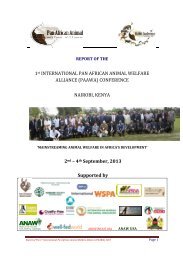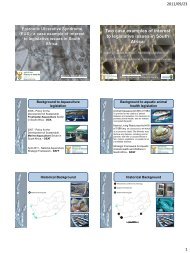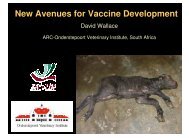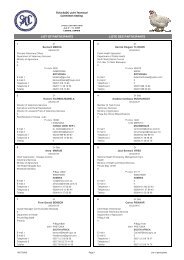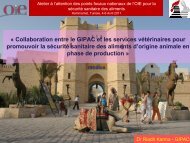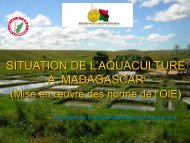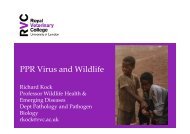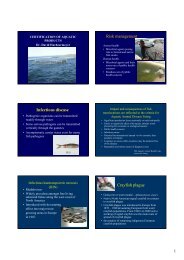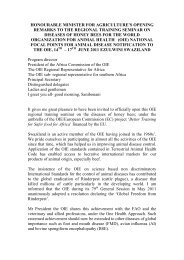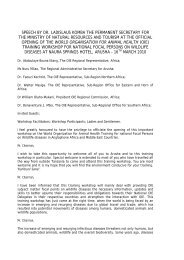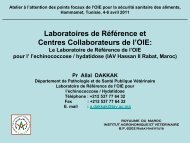Case Study: SPS Issues and Regional Trade in ... - OIE Africa
Case Study: SPS Issues and Regional Trade in ... - OIE Africa
Case Study: SPS Issues and Regional Trade in ... - OIE Africa
Create successful ePaper yourself
Turn your PDF publications into a flip-book with our unique Google optimized e-Paper software.
6. CONCLUSIONSThe only significant trade <strong>in</strong> animal products with<strong>in</strong> SADC is from Namibia <strong>and</strong> Botswanato South <strong>Africa</strong>. South <strong>Africa</strong> is net importer of animal products <strong>and</strong> <strong>in</strong> effect only Botswana<strong>and</strong> Namibia have both surpluses for export <strong>and</strong> can meet the necessary <strong>SPS</strong>requirements. The level of this trade is limited by the more lucrative markets <strong>in</strong> the EU, ascompared with South <strong>Africa</strong>. Currently both Namibia <strong>and</strong> Botswana are, <strong>in</strong> fact, unable tofill their EU quotas. Swazil<strong>and</strong> also has access to the South <strong>Africa</strong>n <strong>and</strong> EU markets buthas structural problems <strong>in</strong> its beef <strong>in</strong>dustry which limit production <strong>and</strong> the country fails tomeets it quotas. In the case of FMD alone, no other country <strong>in</strong> SADC meets therequirements of the <strong>OIE</strong> for beef exports.The <strong>OIE</strong> has been very pro-active <strong>in</strong> promot<strong>in</strong>g the harmonization of <strong>SPS</strong> regulationsthrough programs to ensure that country disease reports are made regularly to the WAHIDdatabase, event notifications are made <strong>and</strong> through the use of the PVS tool to promoteveter<strong>in</strong>ary frameworks (policy, legislation, human capacity <strong>and</strong> <strong>in</strong>frastructure) to deliver onWTO <strong>SPS</strong> commitments by SADC countries. However on any measure the entire animalhealth structures <strong>in</strong> SADC do not compare <strong>in</strong> scope or pro-activeness with those of eitherAustralia or Brazil (countries with similar climates <strong>and</strong> range of animal health issues)despite considerable <strong>in</strong>vestment by the EU, <strong>OIE</strong>, FAO <strong>and</strong> other donor partners. In parallelthere seems limited scope for any <strong>in</strong>crease <strong>in</strong> opportunities for trade with<strong>in</strong> <strong>and</strong> fromSADC that would derive from current programs. For example, while the SADC LIMSproject is active <strong>in</strong> promot<strong>in</strong>g discussions <strong>and</strong> <strong>in</strong>formation shar<strong>in</strong>g among animal healthspecialists <strong>in</strong> the region, an exam<strong>in</strong>ation of the content <strong>in</strong> the various discussions does notseem to conta<strong>in</strong> much that would be of immediate practical benefit <strong>in</strong> terms of trade.<strong>Regional</strong> successes can <strong>in</strong> fact be generally traced to <strong>in</strong>stances of strong public-privatepartnerships, or failures - <strong>in</strong> the case of Zimbabwe, to their disappearance. Examples<strong>in</strong>clude the participation of the private sector commercial farmers <strong>in</strong> Namibia, the ostrichgrowers through their association <strong>in</strong> South <strong>Africa</strong> <strong>and</strong> the success of the newly creatednational cattle producers association <strong>in</strong> Botswana, the BCPA. <strong>Regional</strong>, government <strong>and</strong>donor led programs generally appear to lack commercial direction <strong>and</strong> cutt<strong>in</strong>g edgemanagement if they do not engage with strong private sector partners.29



